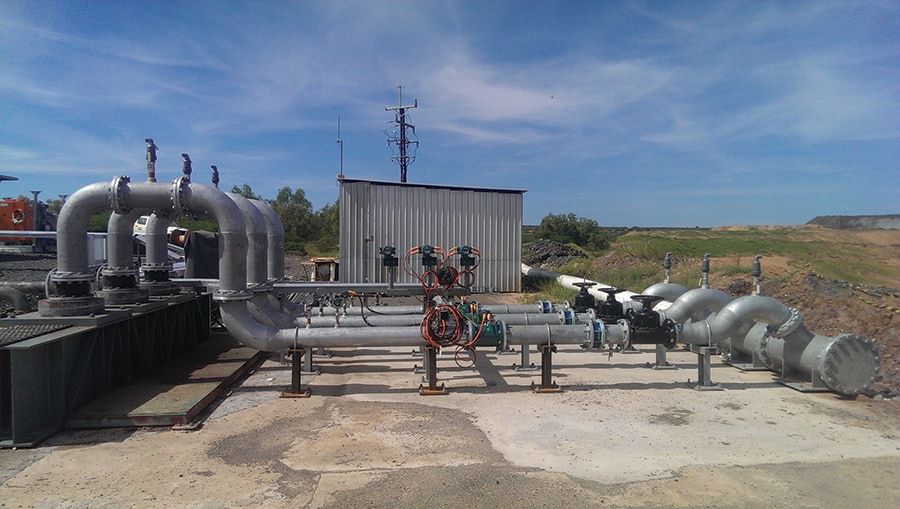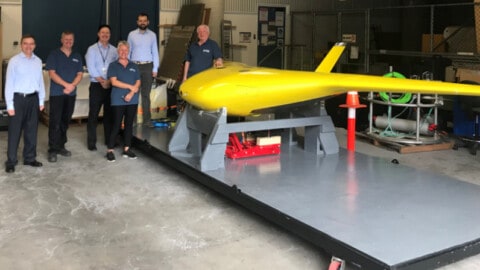The McArthur River mine is currently the largest zinc resource in the world. It is located 45 km south west of the township of Borroloola in the Gulf Region of the Northern Territory, adjacent to the McArthur River. Maintaining the mine site requires extensive water management and dewatering, and a $28 million water management project for the site, awarded to Intech, is currently in its final stages.
Underground operations began at the McArthur River mine site in 1995 and McArthur River Mining Pty Ltd was formed to operate the mine on behalf of the joint venture partners, the GlencoreXstrata group. In 2007-2008 the mine transitioned to open pit development, and over 2011-2013 it underwent a $360 million development project to increase its capacity from 2.5 million tonnes of ore per annum to 5.5 million tonnes, and increase production from 360,000 dry metric tonnes to 800,000 dry metric tonnes per annum.
McArthur River Mining (MRM) is the world’s largest bulk producer of zinc in concentrate form, supplying 70 per cent of global demand for a high-grade bulk zinc-lead-silver concentrate. The mine’s production also represents approximately three per cent of the world’s total zinc resources used by all types of smelters each year.
Concentrate is transported from the mine to MRM’s Bing Bong loading facility by road. From there it is loaded onto a barge and transported to waiting ships at sea in the Gulf of Carpentaria.
Water management on site
Intech were awarded the engineering, procurement and construction management contract for the design and installation of a $28 million water management system project at the McArthur River mine. This project includes the following major elements:
Dewatering infrastructure
•Underground mine dewatering
•Shallow bore dewatering
•Raw, dirty and contaminated ring mains.
Water storage, transfer and discharge infrastructure
•Construction of reservoirs, including 1830 ML WMD Cell 3, 80ML Pond 2 and 120 ML Pete’s Pond
•Transfer of dirty water between reservoirs
•Contaminated water transfer to holding ponds.
Four different models of pumps were used for dewatering at the site:
•Mine dewatering pumps, also known as the evase pumps – three 670 kW 6 stage Schlumberger P2500-A C pumps were installed in a disused mine ventilation shaft.
•Surface Pumps – five 315 kW Sulzer APP53-250 O pumps were installed at three different dams, to pump from one dam to another.
•Bore Pumps – six Lowara model pumps ZN622 13-L6WN were installed at a depth of 100m to pump water from a shallow bore field system to a dam.
•Seal water pumps – three Sulzer J15W were installed to wet the internal seal during the priming phase of the surface pumps. Each of these pumps came with a flotation device and strainer.
Choosing the right pumps for the job
The pumps selected for the project were chosen by evaluating a number of important criteria to suit their application at the site.
Mine dewatering pumps
The three evase pumps were selected according to the requirement for a static head of 385m and a flow rate of 180l/s. The materials offered were judged to be of a superior quality and design and were more than suitable for the process fluid. The slim design of the motor diameter 7.38″ (187.4 mm) gave these pumps an advantage over other pumps for this narrow borehole application. These pumps were also available with the shortest lead time.
Bore pumps
The nominal duty for the bore pumps was a flow rate of 5l/s at 150m head and the expected maximum flow rate was 8l/s. Having one model of pump had advantages; allowing spares to be kept to a minimum. The pumps operate with a desired DOL drive without a VSD.
Surface pumps
The Sulzer surface pumps had a nominal duty of 828m3/hr with total dynamic head of 55m and maximum duty of 1224m3/h with total dynamic head of 60m. The ability of the pumps to draw down the level of the ponds to a nominal 6m below the maximum level was identified as an important performance requirement. →
The pumps were specified by Sulzer to be self-priming units. This presented the advantage of having a built-in design, simplifying the design of the power supply and control system, and negating the need to install and maintain the priming units separately.
Sulzer Pumps offered materials which were determined to be superior to those offered by the other vendors due to a higher wear and corrosion resistance, hence a reduced maintenance requirement and longer operational life of the pumping systems.
The pumps at work
The bore pumps were installed into a vertical vent shaft and used to pump water from disused workings, which have been flooded since the end of underground mining several years ago. The purpose of the system is to lower the water table in the pit.
Water is pumped from the underground workings to a storage pond via HDPE ring main around the perimeter of the pit, where it is currently distributed and used at various locations including water sprays for evaporation, storage dam for dust suppression and at the processing plant.
Pump speed and dewatering flow rates are controlled via VSD. System automation comprises local/remote flow control and leak detection.
Additional infrastructure installed as part of the dewatering system upgrade included surface pump stations and pipelines for the transfer of water from the mine to the location of a future storage facility.
The project nears completion
The project is now wrapping up, with initial priming of the surface system and performance testing having taken place in June.
The greatest challenge for construction was posed by the volatile environmental conditions that characterise the region, according to Intech Business Development Manager David Nolan. However, persistence and flexibility saw the project through.
“Our time at MRM has seen us through two wet seasons. Trying to do any amount of work in a place where you can experience up to 80mm of rain in a matter of hours is always going to be a challenge.
“This was heightened due to a lot of that work being civil based. Along with the rain, our design and construction methodologies have evolved over the past 18 months to adapt to some fairly major changes in the criteria of the system, including a whole new catchment dam and complete relocation of a pump station. Being a smaller company helps when it comes to having to be flexible. Continuous collaboration has allowed us to make design changes on the fly to deal with the roadblocks.”
Overall, Mr Nolan was extremely happy with the results. “The third pump station is currently in the final stages of construction, with completion expected mid-June. Our three submersible pumps that are in an old underground vent shaft have been up and running for approximately three months and have more than doubled the mine’s dewatering capacity. The water level is now well under the bottom of the open pit.
“With the wet season having just passed, the new installation has already been put through its paces. This stage of the project is likely to come to an end by beginning of July. There will likely be a requirement to return in 12 to 18 months’ time for further commissioning and relocation of the submersible bore pumps to keep up with the expanding open pit.”




















